Exploring Sexual and Reproductive Health Communication Issues in Adolescent Oncology Patients
VerifiedAdded on 2023/03/31
|8
|1539
|446
AI Summary
This essay discusses the sexual and reproductive health communication issues experienced by adolescent and young adult oncology patients. It explores the search strategy and critical appraisal of a relevant article on the topic.
Contribute Materials
Your contribution can guide someone’s learning journey. Share your
documents today.
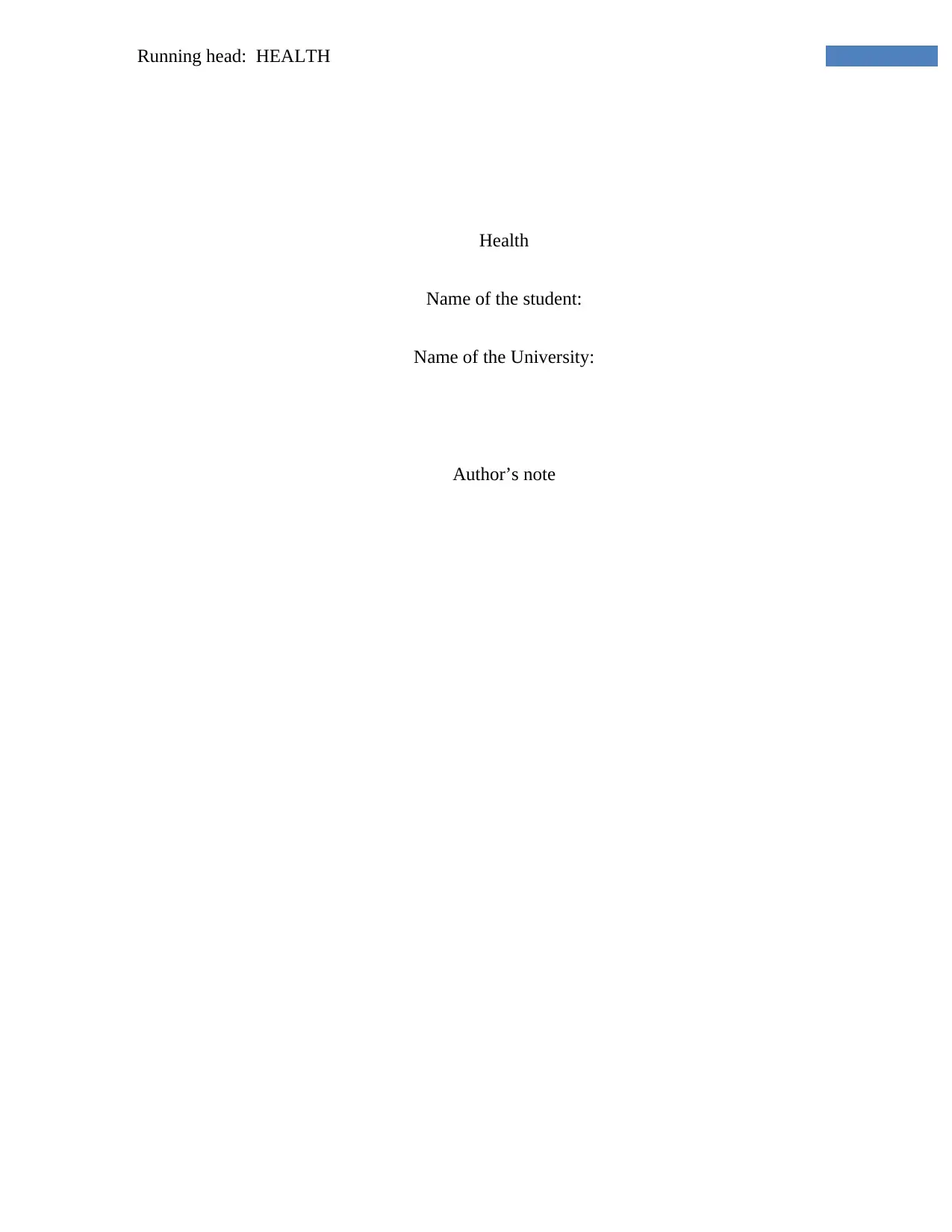
Running head: HEALTH
Health
Name of the student:
Name of the University:
Author’s note
Health
Name of the student:
Name of the University:
Author’s note
Secure Best Marks with AI Grader
Need help grading? Try our AI Grader for instant feedback on your assignments.
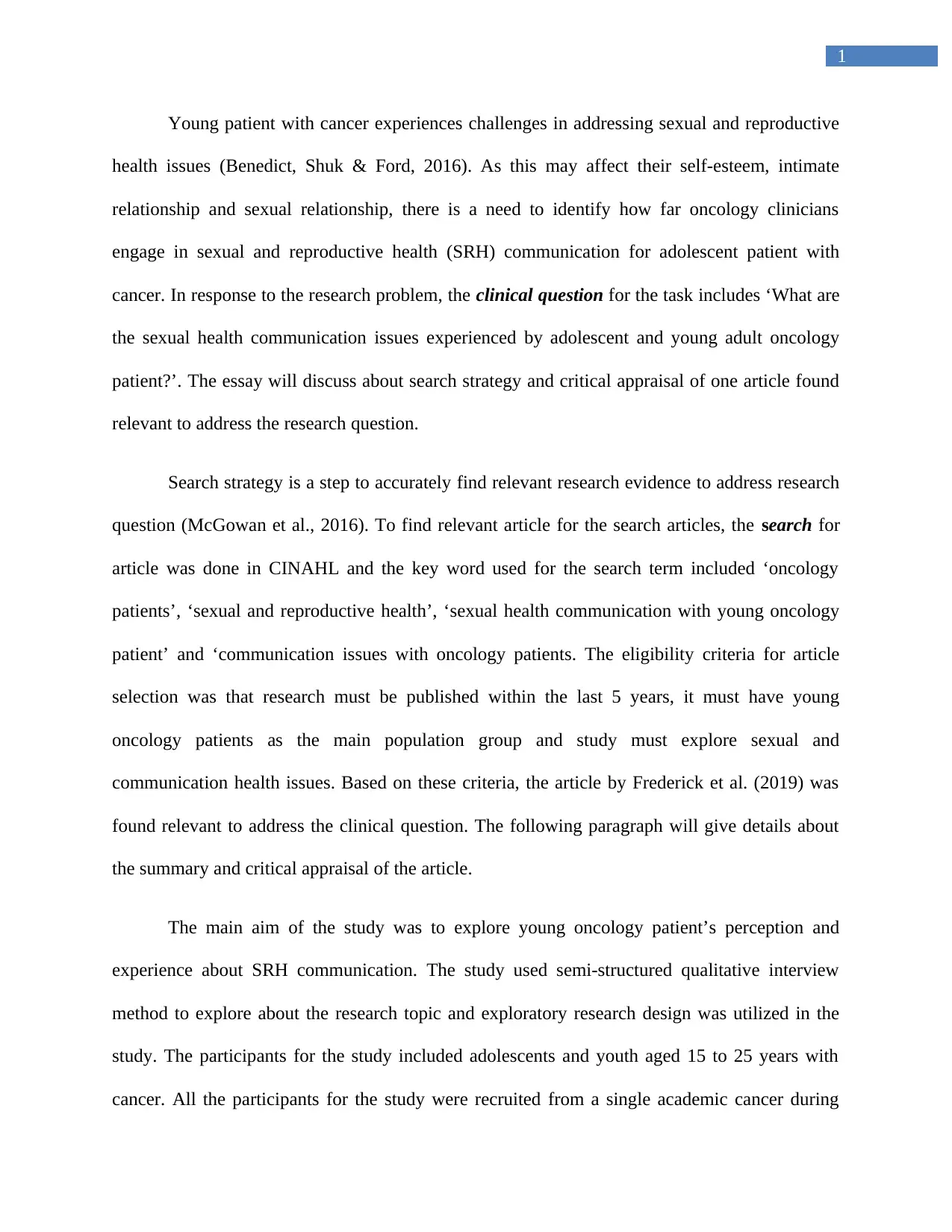
1
Young patient with cancer experiences challenges in addressing sexual and reproductive
health issues (Benedict, Shuk & Ford, 2016). As this may affect their self-esteem, intimate
relationship and sexual relationship, there is a need to identify how far oncology clinicians
engage in sexual and reproductive health (SRH) communication for adolescent patient with
cancer. In response to the research problem, the clinical question for the task includes ‘What are
the sexual health communication issues experienced by adolescent and young adult oncology
patient?’. The essay will discuss about search strategy and critical appraisal of one article found
relevant to address the research question.
Search strategy is a step to accurately find relevant research evidence to address research
question (McGowan et al., 2016). To find relevant article for the search articles, the search for
article was done in CINAHL and the key word used for the search term included ‘oncology
patients’, ‘sexual and reproductive health’, ‘sexual health communication with young oncology
patient’ and ‘communication issues with oncology patients. The eligibility criteria for article
selection was that research must be published within the last 5 years, it must have young
oncology patients as the main population group and study must explore sexual and
communication health issues. Based on these criteria, the article by Frederick et al. (2019) was
found relevant to address the clinical question. The following paragraph will give details about
the summary and critical appraisal of the article.
The main aim of the study was to explore young oncology patient’s perception and
experience about SRH communication. The study used semi-structured qualitative interview
method to explore about the research topic and exploratory research design was utilized in the
study. The participants for the study included adolescents and youth aged 15 to 25 years with
cancer. All the participants for the study were recruited from a single academic cancer during
Young patient with cancer experiences challenges in addressing sexual and reproductive
health issues (Benedict, Shuk & Ford, 2016). As this may affect their self-esteem, intimate
relationship and sexual relationship, there is a need to identify how far oncology clinicians
engage in sexual and reproductive health (SRH) communication for adolescent patient with
cancer. In response to the research problem, the clinical question for the task includes ‘What are
the sexual health communication issues experienced by adolescent and young adult oncology
patient?’. The essay will discuss about search strategy and critical appraisal of one article found
relevant to address the research question.
Search strategy is a step to accurately find relevant research evidence to address research
question (McGowan et al., 2016). To find relevant article for the search articles, the search for
article was done in CINAHL and the key word used for the search term included ‘oncology
patients’, ‘sexual and reproductive health’, ‘sexual health communication with young oncology
patient’ and ‘communication issues with oncology patients. The eligibility criteria for article
selection was that research must be published within the last 5 years, it must have young
oncology patients as the main population group and study must explore sexual and
communication health issues. Based on these criteria, the article by Frederick et al. (2019) was
found relevant to address the clinical question. The following paragraph will give details about
the summary and critical appraisal of the article.
The main aim of the study was to explore young oncology patient’s perception and
experience about SRH communication. The study used semi-structured qualitative interview
method to explore about the research topic and exploratory research design was utilized in the
study. The participants for the study included adolescents and youth aged 15 to 25 years with
cancer. All the participants for the study were recruited from a single academic cancer during
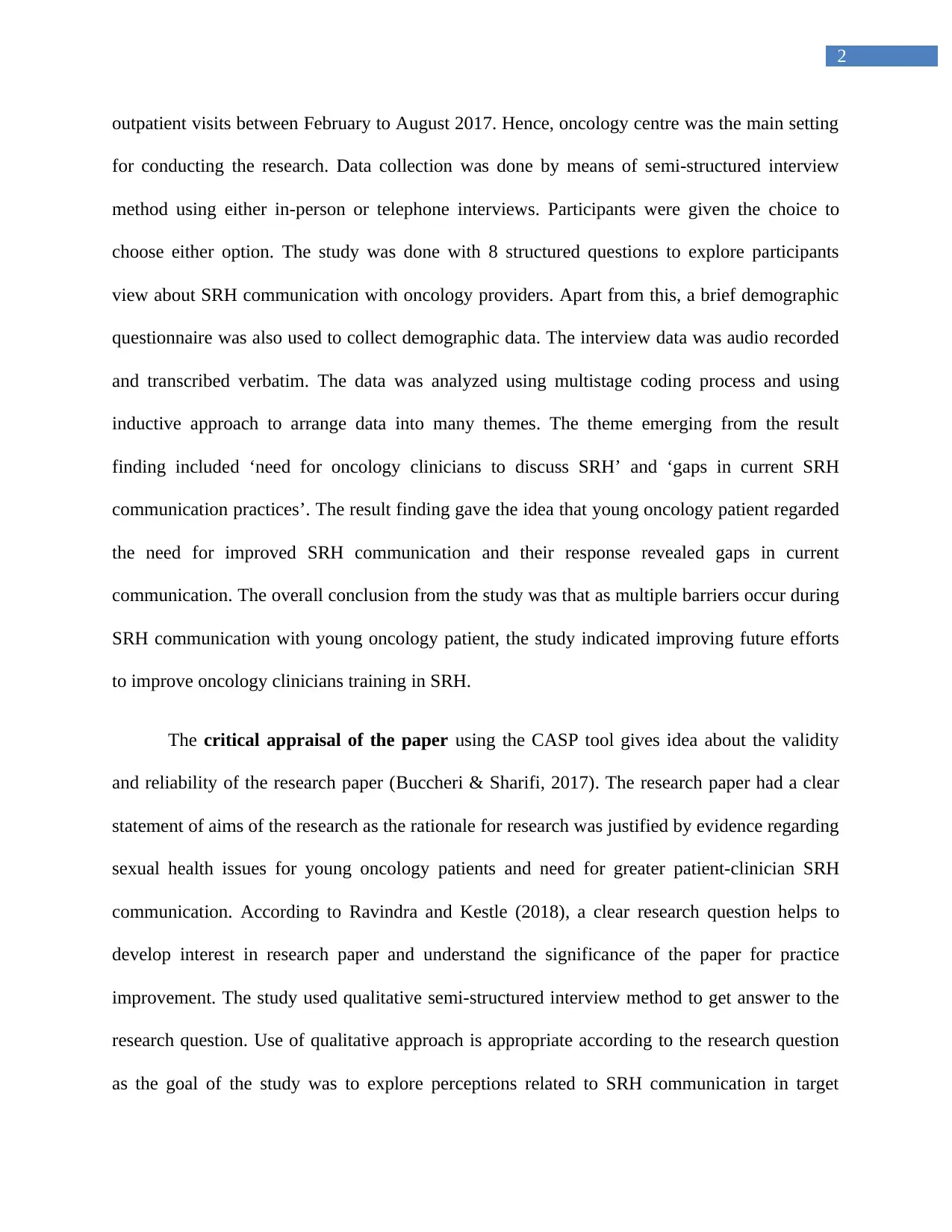
2
outpatient visits between February to August 2017. Hence, oncology centre was the main setting
for conducting the research. Data collection was done by means of semi-structured interview
method using either in-person or telephone interviews. Participants were given the choice to
choose either option. The study was done with 8 structured questions to explore participants
view about SRH communication with oncology providers. Apart from this, a brief demographic
questionnaire was also used to collect demographic data. The interview data was audio recorded
and transcribed verbatim. The data was analyzed using multistage coding process and using
inductive approach to arrange data into many themes. The theme emerging from the result
finding included ‘need for oncology clinicians to discuss SRH’ and ‘gaps in current SRH
communication practices’. The result finding gave the idea that young oncology patient regarded
the need for improved SRH communication and their response revealed gaps in current
communication. The overall conclusion from the study was that as multiple barriers occur during
SRH communication with young oncology patient, the study indicated improving future efforts
to improve oncology clinicians training in SRH.
The critical appraisal of the paper using the CASP tool gives idea about the validity
and reliability of the research paper (Buccheri & Sharifi, 2017). The research paper had a clear
statement of aims of the research as the rationale for research was justified by evidence regarding
sexual health issues for young oncology patients and need for greater patient-clinician SRH
communication. According to Ravindra and Kestle (2018), a clear research question helps to
develop interest in research paper and understand the significance of the paper for practice
improvement. The study used qualitative semi-structured interview method to get answer to the
research question. Use of qualitative approach is appropriate according to the research question
as the goal of the study was to explore perceptions related to SRH communication in target
outpatient visits between February to August 2017. Hence, oncology centre was the main setting
for conducting the research. Data collection was done by means of semi-structured interview
method using either in-person or telephone interviews. Participants were given the choice to
choose either option. The study was done with 8 structured questions to explore participants
view about SRH communication with oncology providers. Apart from this, a brief demographic
questionnaire was also used to collect demographic data. The interview data was audio recorded
and transcribed verbatim. The data was analyzed using multistage coding process and using
inductive approach to arrange data into many themes. The theme emerging from the result
finding included ‘need for oncology clinicians to discuss SRH’ and ‘gaps in current SRH
communication practices’. The result finding gave the idea that young oncology patient regarded
the need for improved SRH communication and their response revealed gaps in current
communication. The overall conclusion from the study was that as multiple barriers occur during
SRH communication with young oncology patient, the study indicated improving future efforts
to improve oncology clinicians training in SRH.
The critical appraisal of the paper using the CASP tool gives idea about the validity
and reliability of the research paper (Buccheri & Sharifi, 2017). The research paper had a clear
statement of aims of the research as the rationale for research was justified by evidence regarding
sexual health issues for young oncology patients and need for greater patient-clinician SRH
communication. According to Ravindra and Kestle (2018), a clear research question helps to
develop interest in research paper and understand the significance of the paper for practice
improvement. The study used qualitative semi-structured interview method to get answer to the
research question. Use of qualitative approach is appropriate according to the research question
as the goal of the study was to explore perceptions related to SRH communication in target
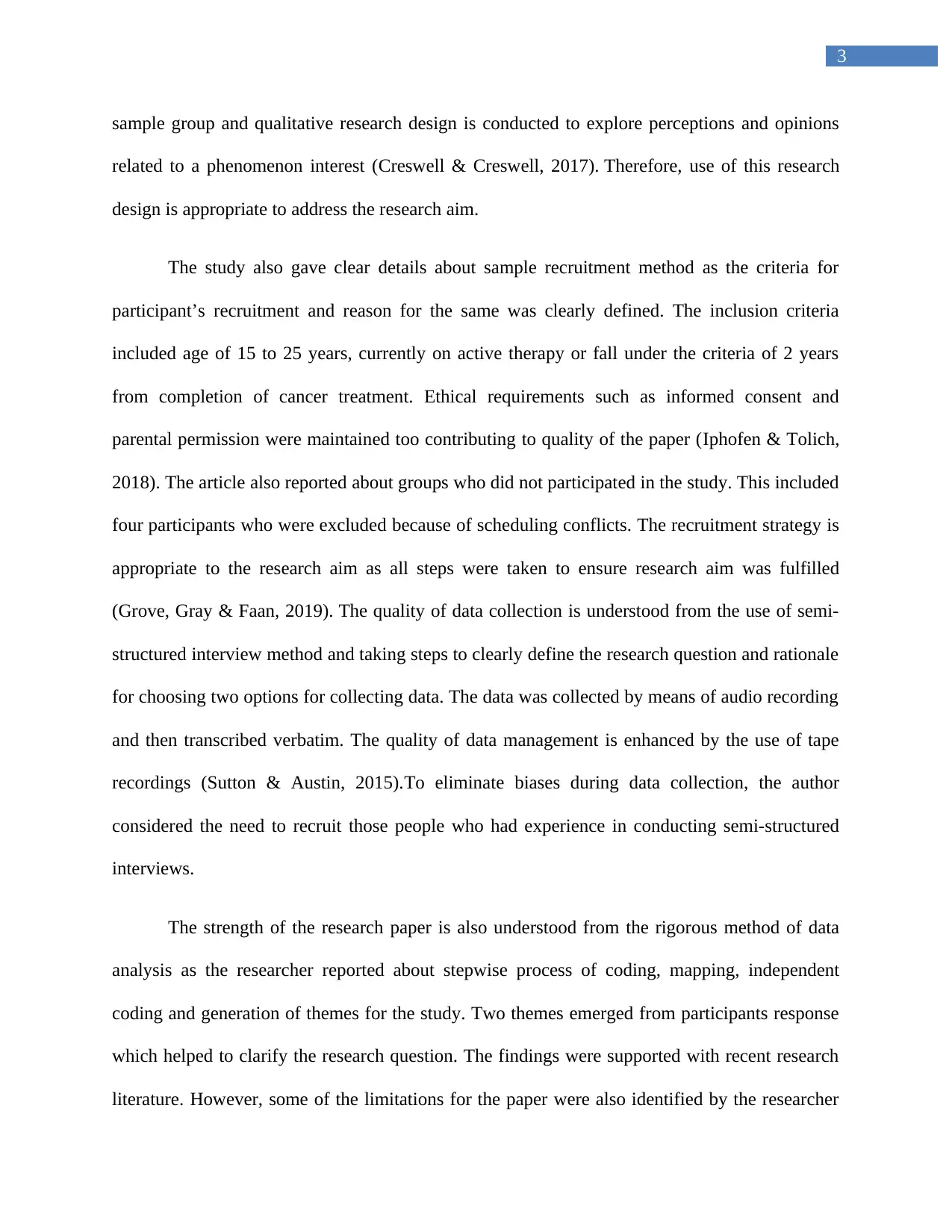
3
sample group and qualitative research design is conducted to explore perceptions and opinions
related to a phenomenon interest (Creswell & Creswell, 2017). Therefore, use of this research
design is appropriate to address the research aim.
The study also gave clear details about sample recruitment method as the criteria for
participant’s recruitment and reason for the same was clearly defined. The inclusion criteria
included age of 15 to 25 years, currently on active therapy or fall under the criteria of 2 years
from completion of cancer treatment. Ethical requirements such as informed consent and
parental permission were maintained too contributing to quality of the paper (Iphofen & Tolich,
2018). The article also reported about groups who did not participated in the study. This included
four participants who were excluded because of scheduling conflicts. The recruitment strategy is
appropriate to the research aim as all steps were taken to ensure research aim was fulfilled
(Grove, Gray & Faan, 2019). The quality of data collection is understood from the use of semi-
structured interview method and taking steps to clearly define the research question and rationale
for choosing two options for collecting data. The data was collected by means of audio recording
and then transcribed verbatim. The quality of data management is enhanced by the use of tape
recordings (Sutton & Austin, 2015).To eliminate biases during data collection, the author
considered the need to recruit those people who had experience in conducting semi-structured
interviews.
The strength of the research paper is also understood from the rigorous method of data
analysis as the researcher reported about stepwise process of coding, mapping, independent
coding and generation of themes for the study. Two themes emerged from participants response
which helped to clarify the research question. The findings were supported with recent research
literature. However, some of the limitations for the paper were also identified by the researcher
sample group and qualitative research design is conducted to explore perceptions and opinions
related to a phenomenon interest (Creswell & Creswell, 2017). Therefore, use of this research
design is appropriate to address the research aim.
The study also gave clear details about sample recruitment method as the criteria for
participant’s recruitment and reason for the same was clearly defined. The inclusion criteria
included age of 15 to 25 years, currently on active therapy or fall under the criteria of 2 years
from completion of cancer treatment. Ethical requirements such as informed consent and
parental permission were maintained too contributing to quality of the paper (Iphofen & Tolich,
2018). The article also reported about groups who did not participated in the study. This included
four participants who were excluded because of scheduling conflicts. The recruitment strategy is
appropriate to the research aim as all steps were taken to ensure research aim was fulfilled
(Grove, Gray & Faan, 2019). The quality of data collection is understood from the use of semi-
structured interview method and taking steps to clearly define the research question and rationale
for choosing two options for collecting data. The data was collected by means of audio recording
and then transcribed verbatim. The quality of data management is enhanced by the use of tape
recordings (Sutton & Austin, 2015).To eliminate biases during data collection, the author
considered the need to recruit those people who had experience in conducting semi-structured
interviews.
The strength of the research paper is also understood from the rigorous method of data
analysis as the researcher reported about stepwise process of coding, mapping, independent
coding and generation of themes for the study. Two themes emerged from participants response
which helped to clarify the research question. The findings were supported with recent research
literature. However, some of the limitations for the paper were also identified by the researcher
Secure Best Marks with AI Grader
Need help grading? Try our AI Grader for instant feedback on your assignments.
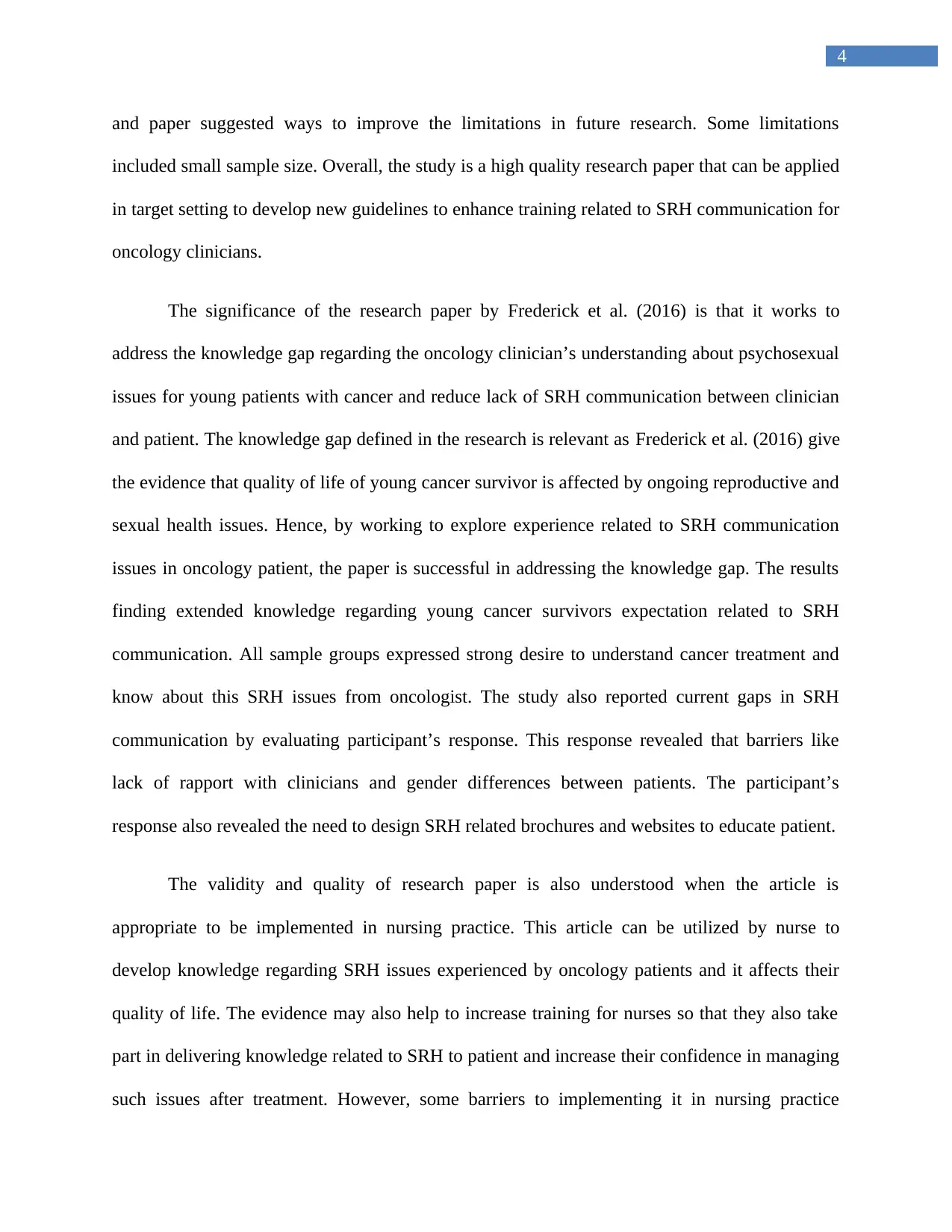
4
and paper suggested ways to improve the limitations in future research. Some limitations
included small sample size. Overall, the study is a high quality research paper that can be applied
in target setting to develop new guidelines to enhance training related to SRH communication for
oncology clinicians.
The significance of the research paper by Frederick et al. (2016) is that it works to
address the knowledge gap regarding the oncology clinician’s understanding about psychosexual
issues for young patients with cancer and reduce lack of SRH communication between clinician
and patient. The knowledge gap defined in the research is relevant as Frederick et al. (2016) give
the evidence that quality of life of young cancer survivor is affected by ongoing reproductive and
sexual health issues. Hence, by working to explore experience related to SRH communication
issues in oncology patient, the paper is successful in addressing the knowledge gap. The results
finding extended knowledge regarding young cancer survivors expectation related to SRH
communication. All sample groups expressed strong desire to understand cancer treatment and
know about this SRH issues from oncologist. The study also reported current gaps in SRH
communication by evaluating participant’s response. This response revealed that barriers like
lack of rapport with clinicians and gender differences between patients. The participant’s
response also revealed the need to design SRH related brochures and websites to educate patient.
The validity and quality of research paper is also understood when the article is
appropriate to be implemented in nursing practice. This article can be utilized by nurse to
develop knowledge regarding SRH issues experienced by oncology patients and it affects their
quality of life. The evidence may also help to increase training for nurses so that they also take
part in delivering knowledge related to SRH to patient and increase their confidence in managing
such issues after treatment. However, some barriers to implementing it in nursing practice
and paper suggested ways to improve the limitations in future research. Some limitations
included small sample size. Overall, the study is a high quality research paper that can be applied
in target setting to develop new guidelines to enhance training related to SRH communication for
oncology clinicians.
The significance of the research paper by Frederick et al. (2016) is that it works to
address the knowledge gap regarding the oncology clinician’s understanding about psychosexual
issues for young patients with cancer and reduce lack of SRH communication between clinician
and patient. The knowledge gap defined in the research is relevant as Frederick et al. (2016) give
the evidence that quality of life of young cancer survivor is affected by ongoing reproductive and
sexual health issues. Hence, by working to explore experience related to SRH communication
issues in oncology patient, the paper is successful in addressing the knowledge gap. The results
finding extended knowledge regarding young cancer survivors expectation related to SRH
communication. All sample groups expressed strong desire to understand cancer treatment and
know about this SRH issues from oncologist. The study also reported current gaps in SRH
communication by evaluating participant’s response. This response revealed that barriers like
lack of rapport with clinicians and gender differences between patients. The participant’s
response also revealed the need to design SRH related brochures and websites to educate patient.
The validity and quality of research paper is also understood when the article is
appropriate to be implemented in nursing practice. This article can be utilized by nurse to
develop knowledge regarding SRH issues experienced by oncology patients and it affects their
quality of life. The evidence may also help to increase training for nurses so that they also take
part in delivering knowledge related to SRH to patient and increase their confidence in managing
such issues after treatment. However, some barriers to implementing it in nursing practice

5
include lack of resource and educational material to educate nurses about SRH issues and ways
to communicate this with patient. The clinical leaders need to reinforce the need for developing
such knowledge in nurses and taking appropriate steps to address resource needs too.
include lack of resource and educational material to educate nurses about SRH issues and ways
to communicate this with patient. The clinical leaders need to reinforce the need for developing
such knowledge in nurses and taking appropriate steps to address resource needs too.
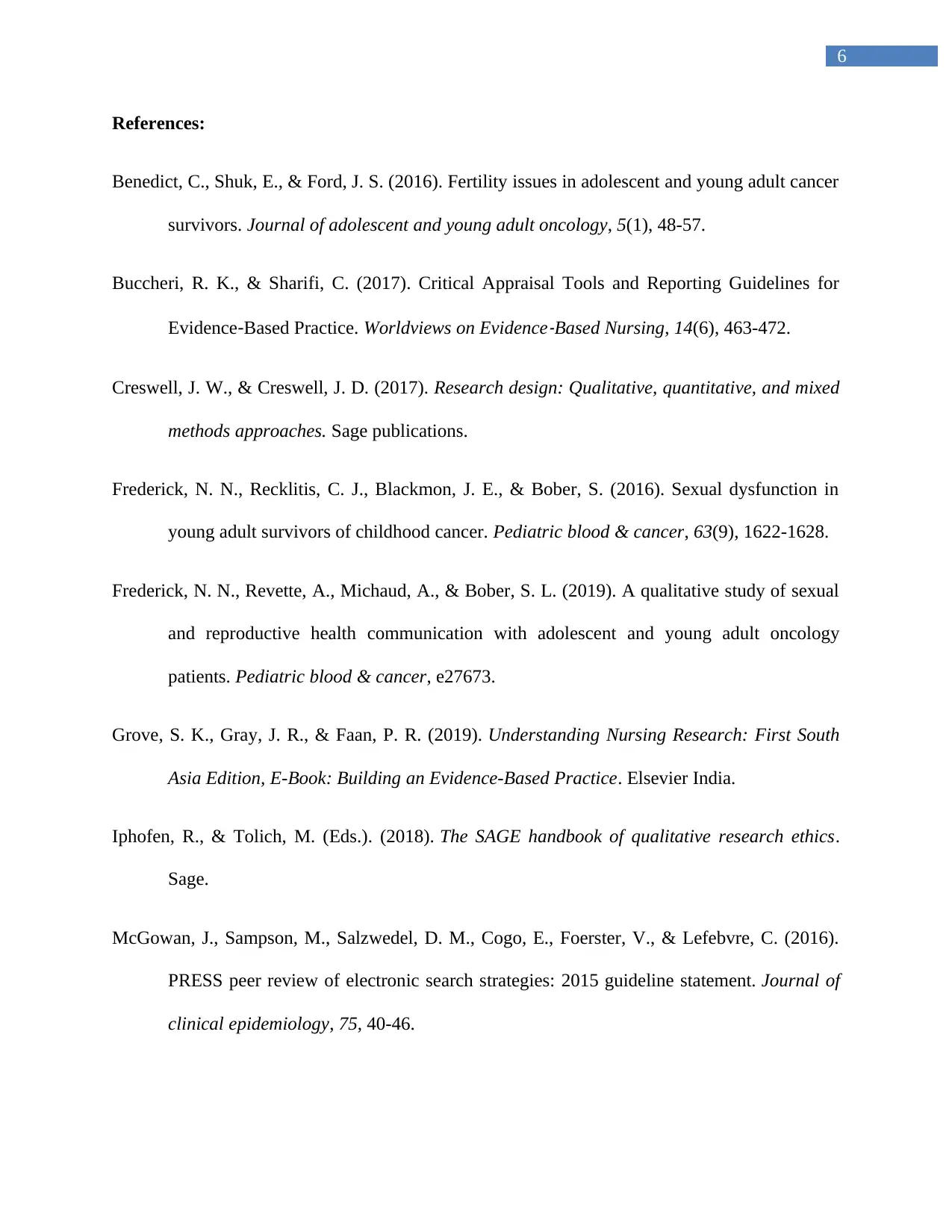
6
References:
Benedict, C., Shuk, E., & Ford, J. S. (2016). Fertility issues in adolescent and young adult cancer
survivors. Journal of adolescent and young adult oncology, 5(1), 48-57.
Buccheri, R. K., & Sharifi, C. (2017). Critical Appraisal Tools and Reporting Guidelines for
Evidence‐Based Practice. Worldviews on Evidence
‐Based Nursing, 14(6), 463-472.
Creswell, J. W., & Creswell, J. D. (2017). Research design: Qualitative, quantitative, and mixed
methods approaches. Sage publications.
Frederick, N. N., Recklitis, C. J., Blackmon, J. E., & Bober, S. (2016). Sexual dysfunction in
young adult survivors of childhood cancer. Pediatric blood & cancer, 63(9), 1622-1628.
Frederick, N. N., Revette, A., Michaud, A., & Bober, S. L. (2019). A qualitative study of sexual
and reproductive health communication with adolescent and young adult oncology
patients. Pediatric blood & cancer, e27673.
Grove, S. K., Gray, J. R., & Faan, P. R. (2019). Understanding Nursing Research: First South
Asia Edition, E-Book: Building an Evidence-Based Practice. Elsevier India.
Iphofen, R., & Tolich, M. (Eds.). (2018). The SAGE handbook of qualitative research ethics.
Sage.
McGowan, J., Sampson, M., Salzwedel, D. M., Cogo, E., Foerster, V., & Lefebvre, C. (2016).
PRESS peer review of electronic search strategies: 2015 guideline statement. Journal of
clinical epidemiology, 75, 40-46.
References:
Benedict, C., Shuk, E., & Ford, J. S. (2016). Fertility issues in adolescent and young adult cancer
survivors. Journal of adolescent and young adult oncology, 5(1), 48-57.
Buccheri, R. K., & Sharifi, C. (2017). Critical Appraisal Tools and Reporting Guidelines for
Evidence‐Based Practice. Worldviews on Evidence
‐Based Nursing, 14(6), 463-472.
Creswell, J. W., & Creswell, J. D. (2017). Research design: Qualitative, quantitative, and mixed
methods approaches. Sage publications.
Frederick, N. N., Recklitis, C. J., Blackmon, J. E., & Bober, S. (2016). Sexual dysfunction in
young adult survivors of childhood cancer. Pediatric blood & cancer, 63(9), 1622-1628.
Frederick, N. N., Revette, A., Michaud, A., & Bober, S. L. (2019). A qualitative study of sexual
and reproductive health communication with adolescent and young adult oncology
patients. Pediatric blood & cancer, e27673.
Grove, S. K., Gray, J. R., & Faan, P. R. (2019). Understanding Nursing Research: First South
Asia Edition, E-Book: Building an Evidence-Based Practice. Elsevier India.
Iphofen, R., & Tolich, M. (Eds.). (2018). The SAGE handbook of qualitative research ethics.
Sage.
McGowan, J., Sampson, M., Salzwedel, D. M., Cogo, E., Foerster, V., & Lefebvre, C. (2016).
PRESS peer review of electronic search strategies: 2015 guideline statement. Journal of
clinical epidemiology, 75, 40-46.
Paraphrase This Document
Need a fresh take? Get an instant paraphrase of this document with our AI Paraphraser
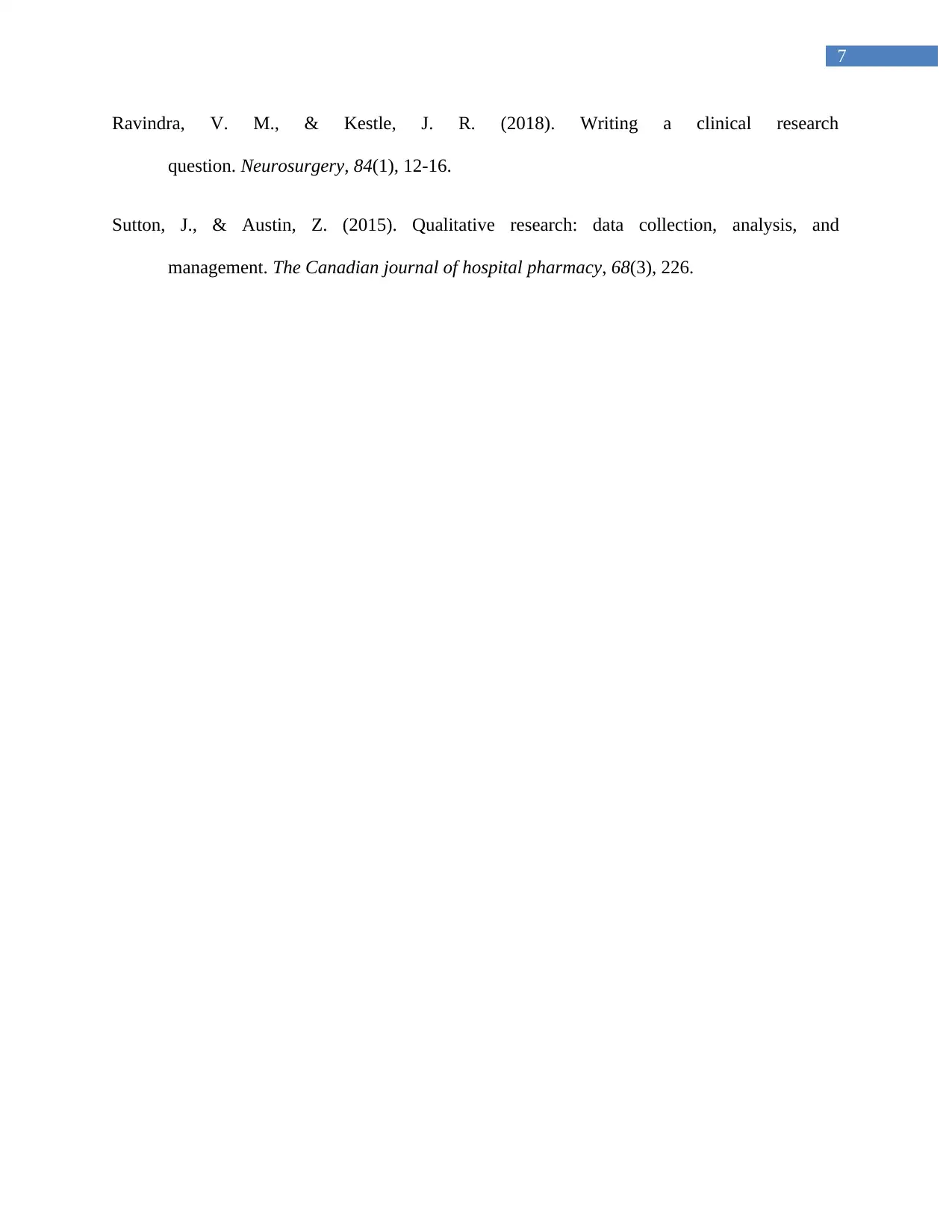
7
Ravindra, V. M., & Kestle, J. R. (2018). Writing a clinical research
question. Neurosurgery, 84(1), 12-16.
Sutton, J., & Austin, Z. (2015). Qualitative research: data collection, analysis, and
management. The Canadian journal of hospital pharmacy, 68(3), 226.
Ravindra, V. M., & Kestle, J. R. (2018). Writing a clinical research
question. Neurosurgery, 84(1), 12-16.
Sutton, J., & Austin, Z. (2015). Qualitative research: data collection, analysis, and
management. The Canadian journal of hospital pharmacy, 68(3), 226.
1 out of 8
Related Documents
Your All-in-One AI-Powered Toolkit for Academic Success.
+13062052269
info@desklib.com
Available 24*7 on WhatsApp / Email
![[object Object]](/_next/static/media/star-bottom.7253800d.svg)
Unlock your academic potential
© 2024 | Zucol Services PVT LTD | All rights reserved.




